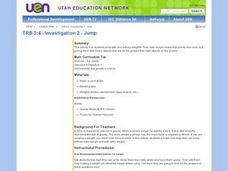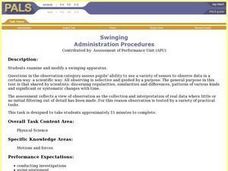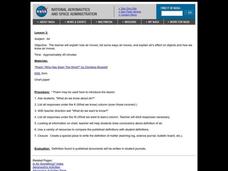Curated OER
What Can Change an Object's Motion?
In this object in motion worksheet, students will brainstorm ideas of what can change an object's motion. Then the student will write in supporting details for each idea in a graphic organizer.
Curated OER
Newton's Laws of Motion
In this physics worksheet, students identify and locate vocabulary terms related to Newton's Laws of Motion. There are 16 words located in the puzzle.
Curated OER
Forces And Energy
Students investigate the atom and how it is formed. They conduct research using a variety of resources and then construct a model of the atom. Then students have class discussion. The instructional activity includes background...
Curated OER
Jumping Explorations
Students work with a partner to follow the pathway-jumping in the different suggested ways. They listen to music to rotate from station to station. Students their favorite stations and levels of difficulty. They discuss the use of...
Curated OER
TRB 3:4 - Investigation 2 - Jump
Third graders jump with and without weights to reveal data that gravity has more of a pulling force with heavy objects that are on the ground than light objects on the ground. They also identify how their legs felt when they jumped with...
Curated OER
Bungee Barbie
Pupils discover the relationship between force and the amount of time over which the force is applied. They discover the meaning of impulse and it equals the change of momentum. Students connect things to a computer to test their results.
Curated OER
Forces and Acceleration
Students discover the relationship between force and acceleration in a skateboard experiment. In small groups, they attach a spring balance to a skateboard and pull a group member across the floor using a constant amount of force. They...
Curated OER
Traveling Bowls
Students investigate the relationship between force and motion while conducting an experiment to answer the question,"How do objects move?". In small groups, they predict how many washers are needed to pull a bowl across a finish line.
Curated OER
Pressure Versus Force: Landing On Ice!
High schoolers experiment with the relationship between pressure, force, and area. They determine the force and pressure exerted by a LC-130, which is commonly used for cargo and personnel transport in Antarctica.
Curated OER
What Structural Challenges Do Bridge Builders Face Today?
Young scholars investigate the process of constructing a bridge. They study the meaning of structural force and draw pictures of examples. Students identify the types of building materials have been used in history to construct bridges...
Curated OER
Gravitational Factors
Learners identify the forces that affect the weight of an object. In groups, they determine the proper math model which can demonstrate the attraction between two objects based on gravity. They discuss the relationship between the weight...
Curated OER
Marvelous Magnets
Young scholars identify and classify magnetic and nonmagnetic materials and metals. After determining which materials and metals are magnetic, students create a data table and classify items by two different criteria. Young scholars...
Curated OER
Falling
Students should describe the path that the motion would take as well as what might begin or stop the motion. The common characteristic of all the motions that students have experienced directly is that one or more forces are acting on...
Curated OER
In-Line Inertia
Students practice calculating the moment of inertia when discussing a skater and the position in which it is best to spin. After class discussion, students practice calculating inertia on their own.
Curated OER
That Mu You Do
Students discussion frictional force, kinetic friction, and static friction and the role each plays in acceleration and velocity in relationship to a car and the road on which it is traveling. Students complete activity answering review...
Curated OER
Newton's Earthquake
Young scholars discuss Newton's 2nd and 3rd laws using the example of a football linebacker and a small child pushing against each other on an ice rink. Students are able to visualize the results of the push and link it to the laws....
Curated OER
What Makes a Kite Fly?
Ninth graders compare the nature of forces of gravity, lift, thrust, and drag. They select proper materials for making a kite and attach a proper tail. Students interpret and summarize the observations made during the flight of the kites.
Curated OER
Swinging Observations
Students build a pendulum type swinging apparatus and make specific and selective observations using what they know about scientific observations. They look for regularities of movement, patterns, and systemic changes over time.
Curated OER
Swinging on a String
Students explore how pendulums work and why they are useful in everyday applications. In a hands-on activity, they experiment with string length, pendulum weight and angle of release.
Curated OER
Work Air Does
Students complete a lab observation form predicting how air makes a helicopter and pinwheel work. Constructing their own helicopter, they begin to drop it from various heights. They discuss the force on air and how it affects both objects.
Curated OER
Air
Students complete a KWL chart on what they know about air. Reading a poem, they compare published definitions of air with the ones they created. They write the definition of air on a bullentin board. They also write their observations in...
Curated OER
The Heat is On
Third graders experiment with heat through investigations. They rub objects together and compare the relative differences in the amount of heat given off. They write in their journals about the results they find.
Curated OER
Weighing In
Third graders use a Slinky, rubber bands, paper, coins and cups to experiment with weight and its relationship to gravity. They discuss their results and develop a consensus on conclusion statements derived from their experiments.
Curated OER
Rollin' On
Third graders investigate the effects of gravity on the motion of a marble on an inclined plane and a declined plane. They work in small cooperative groups to predict and explain outcomes.

























